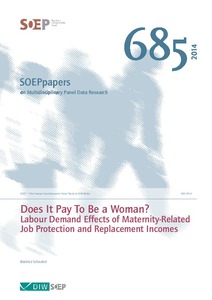Does it pay to be a woman? Labour demand effects of maternity-related job protection and replacement incomes

Deutsches Institut für Wirtschaftsforschung, Berlin
DIW - Berlin
2014
41 p.
gender ; maternity ; wage differential ; working mother
SOEPpapers on Multidisciplinary Panel Data Research
685
Gender equality & Women
English
Bibliogr.
"In countries with strong employment protection laws it is often considered to be unwise to hire a woman in childbearing age because she might get pregnant. However, such labour demand e ects of job protection measures related to maternity leave are often rather anecdotal. To provide analytical evidence, this paper studies the impact of changes in maternity-related job protection in Germany on employment opportunities for women in childbearing age without children for whom the observed e ects should be largely demand-related. Exogenous, discrete policy changes in the German labour market of the 1980s and 1990s constitute the setting for a difference-in-differences analysis of the transition into employment as well as wages. The data for this study are taken from the German Socio-Economic Panel and from the German Microcensus. Doubling the job-protected leave period from 6 months to 12 months between 1986 and 1988 led to an approximately 6% lower probability of being hired for women in childbearing age without a university degree.In addition, I nd a 5-10% increase in wages for women in childbearing age associated with the latter reform. Since this effect disappears when controlling for having a child in the future, this may indicate an increased need to signal commitment by increased effort after the reform."
Digital
The ETUI is co-funded by the European Union. Views and opinions expressed are however those of the author(s) only and do not necessarily reflect those of the European Union or the ETUI.